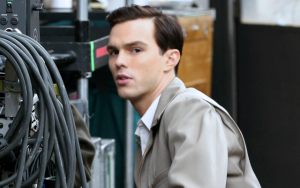REBEL IN THE RYE: 2 STARS. “You never saw so many phonies in all your life.”
 “Rebel in the Rye” is a glossy look at author J.D. Salinger’s unlikely journey from losing a girlfriend to Charlie Chaplin to World War II, from eastern religion to Holden Caulfield. It’s a long strange trip, but would Caulfield label it phoney?
“Rebel in the Rye” is a glossy look at author J.D. Salinger’s unlikely journey from losing a girlfriend to Charlie Chaplin to World War II, from eastern religion to Holden Caulfield. It’s a long strange trip, but would Caulfield label it phoney?
Nicholas Hoult plays Jerome David Salinger, a young man with a talent for words but a father (Victor Garber) who wants him to go into the meat and cheese distribution business. The sharp-tongued teenager isn’t accepted into uptown New York City society and is too square for downtown. The only things he’s good at are getting kicked out of school and writing.
His talent leads him to Columbia University and the Creative Writing class of Whit Burnett (Kevin Spacey). Burnett recognizes Salinger’s gift but isn’t sure of his commitment to the writing life.
Meanwhile, Salinger is a man about town who begins a tumultuous and ill-fated relationship with Eugene O’Neill’s daughter Oona (Zoey Deutch), a pairing that begins his journey towards writing his most famous book.
First though, he yearns to get a short story published. Sights set on Esquire and The New Yorker he receives rejection after rejection until Burnett publishes “The Young Folks,” in a small literary magazine.
Salinger gets some notice, a high-powered agent Dorothy Olding (Sarah Paulson) and a healthy disdain of “phonies,” superficial people who talk one way and behave another. “My father hides the fact that he’s Jewish from our neighbours,” he says. “The first phoney I ever met was on my first day.”
At Burnett’s urging Salinger begins writing a book. “Holden Caulfield deserves a novel all his own,” Burnett drunkenly slurs after a night on the town. “Imagine the book you would like to read and then go write it.”
His burgeoning career is cut short, interrupted by World War II. Overseas he continues to write—he storms Normandy with six chapters of what would become the classic “Catcher in the Rye” in his pack—but when he returns to the United States he suffers PTSD and is unable to continue. “I have nothing left to say about Holden Caulfield,” he says. “Nothing left to say at all.”
Spiralling downward, his life is changed when he discovers meditation as a way to quiet his mind. He picks up the story of a troubled kid during the Christmas holidays, finishing “Catcher in the Rye.” The book is an immediate hit, capturing the consciousness of the nation. Salinger becomes a media star but his newfound fame and interactions with disturbed fans people who think they are Caulfield drive him from public life. In his remote New Hampshire home he built walls, physically around his home and mentally, to keep everyone out. “When people become a distraction,” he says, you remove the distraction.” He dedicates his life to writing—something his mentor Burnett was unsure he’d be able to do—but removes the pressure of having to follow up one of the most popular novels of all time by never publishing another word.
The word “phoney” looms large in the legacy of J.D. Salinger. His process was a search for authenticity, a journey writer and director Danny Strong seems to have veered away from. The handsome production design and period details bring style to a film that is almost completely without substance. The complex issues of innocence, identity, belonging, loss and connection that Salinger loved and brought to his work are reduced to platitudes. Yes, the World War II scenes effectively showcase the horrors of war but Salinger’s reaction to them feel, well, phoney. Later, when he finally begins to create again it’s because he “learns to write not to show off his talent, but to display what is in his heart.” It’s a line that would have made the real life Salinger red faced and the movie is full of them.
From its on-the-nose title to the standard biopic conventions “Rebel in the Rye” could probably best be described by Caulfield himself: “You never saw so many phonies in all your life.”
